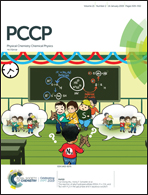The influence of cholesterol on melittin lipidation in neutral membranes†
Abstract
The effects of cholesterol on the process of intrinsic lipidation, whereby an acyl chain is transferred from a lipid as donor to a membrane-associated acceptor molecule, have been explored using melittin as the acceptor. Membranes comprising lipids with saturated acyl chains (1,2-dipalmitoyl sn-glycero-3-phosphocholine, DPPC; 1,2-dimyristoyl sn-glycero-3-phosphocholine, DMPC) yielded no acyl transfer, whereas membranes composed of lipids with unsaturated acyl chains (1,2-dioleoyl sn-glycero-3-phosphocholine, DOPC; 1-palmitoyl-2-oleoyl sn-glycero-3-phosphocholine, POPC) produced detectable lipidation activity. For all lipids, inclusion of cholesterol led to a significant increase in lipidation activity, with the greatest effect observed for 20 mol% cholesterol in POPC. In the case of membranes composed of POPC, the inclusion of cholesterol also produced small changes in the selectivity for transfer from the sn-1 vs. sn-2 positions of the lipid. Qualitatively, for fluid membranes, the trend in lipidation activity exhibits a positive correlation with the bending modulus of the bilayer and is accounted for in terms of the penetration depth of the peptide. Access of water to reactive intermediates also has the potential to influence lipidation rates.



 Please wait while we load your content...
Please wait while we load your content...